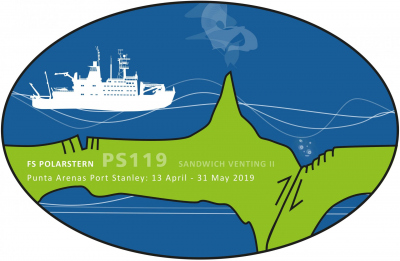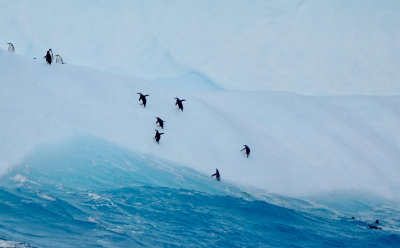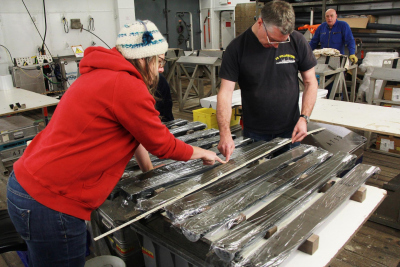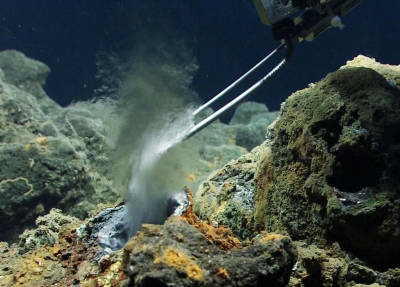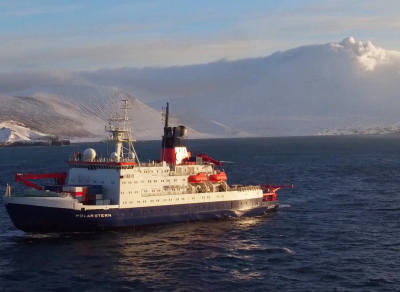- Home
- Research
- Expeditions
- 2019
- PS119
- PS119 – 6th Weekly Report
To the smoking volcano of Saunders Island
PS119 – 6th Weekly Report, 13. – 19.5.19
Like last week, we spent the sixth week in the southernmost area of the South Sandwich Plate, from the back-arc spreading ridge of the segments 8 and 9 in the west to the Kemp Caldera. The volcano of Kemp Caldera is part of the collision zone with the South American plate to the East. A look to our expedition logo shows symbolically the spreading ridge on the left and flowing to the right the volcanoes, fore-arc area and subduction zone.
The weather conditions, which denied from Sunday to Tuesday morning further dives, permitted not until Tuesday to dive down with ROV MARUM-QUEST to the seafloor. We used the dive-free time for the deployment of other sampling gear. On Sunday, 12th of May, we sampled the deepest area of the Kemp caldera with a three meters long gravity corer and the multi-corer.
The until then surveyed Parasound profiles over the caldera showed in the deepest area narrow sediment layers, whose mineral and chemical composition in references to hydrothermal deposits are of huge interest. With our corers we were able to sample sediment layers of 230 centimeters depth, which surprised us by their colouring and diverse sediment compositions.
Pure biogenic opal ooze came to show, which are composed of diatom skeletons. These diatoms are growing in huge numbers in the surface waters of the Southern Ocean, south of the Polar Front, and after death, their skeletons are deposited on the sea floor along the so-called Opal Belt. Especially obvious in the recovered core are the mats of the diatom genus Thalassiotrix, which are built from needle-like cell covers of biogenic opal and if appearing with a single species in the sediment core, look like wet paper tissues. The pure opal ooze is strongly coloured in some layers by metal sulphides, documenting the hydrothermal activity in the caldera over time.
On Monday, 13th of May, we sampled sediments by piston corer about 60 kilometers to the west of the Kemp Caldera on the eastern flank of the ridge segment E8. The sediments of the 8.70 meter long core had high contents of volcanic components and our geochemists are interested in investigating the influence of the hydrothermal activity and especially that of the iron geochemistry.
Out of this interest, pore water samples were taken every 10 centimeters along the length of the core to measure alkalinity and iron concentrations already on board. Further nutrients and specific dissolved components will be analysed after the expedition in the labs of the home institutes.
On Tuesday, 14th of May, the Kemp Caldera was back in the centre of our research. Several CTD and water rosette stations were taken near the hydrothermal area, in the caldera centre and on the rim area. Based on anomalies of turbidity, redox potential, temperature and methane content we wanted to analayse the influence of the active hydrothermal area on the seawater chemistry. A ROV dive followed located at the northern, inner rim of the Kemp Caldera in 1100 meters water depth, over an area where we had detected gas bubble streams several times in the water column. Diving with ROV MARUM-QUEST, we were unable to find the original exit of the gas bubbles on the seafloor, and therefore we concentrated our efforts on sampling the hydrothermal fluids of new discovered smokers.
A black smoker, whose fluid temperatures were measured as 230°C, had a high iron concentration and low pH values of 2.3, while a second chimney which we sampled had a temperature of 200°C contained almost no iron and had a pH of 5.5. We have to wait until after the detailed fluid analyses at home to find out if the fluid chemistry is in line with the precipitate content.
Although further dive destination wishes have arisen during our three dives in the Kemp Caldera, we had to leave this area on the 15th of May in view of our further expedition objectives. Our route lead us along the northwestern part of the South Sandwich Plate to the fore-arc, passing the islands of Leskov, Visokoi and Zavadovski. We run an OFOBS profile over a fore-arc high, in the hope to find indicators for cold seepage. There, British scientists had dredged up serpentinite crustal rocks a few years ago, which are associated with active seafloor fluid exits in other oceans.
During the night, we progressed southwards, reaching the volcanic Saunders Island in the morning of the 17th of May. Our volcanologists had planned a visit with sampling and a photogrammetrically survey via drone flights. In light of the weather, which improved as the day went by, drone flights starting from POLARSTERN were possible, especially after the ship made its way through Cordelia Bay and stopped very close to the island.
A further successful ROV dive took place in the hydrothermal area E2-South on Saturday, 18th of May, before the weather got bad during the night. As a strong storm of up to hurricane level was forecasted for the second part of the night and the following morning, we steamed with POLARSTERN westwards and found shelter behind the volcanic island Zavodovski. With a wind strength of ten to eleven Beaufort with occasional gusts of 12, we had waves of three to four meters height in the shelter of the island while further out waves of more than eight meters height were forecasted. Despite the fact that the vessel is more rocking and rolling today, we feel and well looked after on POLARSTERN. However, not all scientists were seen for breakfast and lunch.
Best wishes in the name of all participants,
Gerhard Bohrmann, RV POLARSTERN, Sunday, 19th of May 2019



